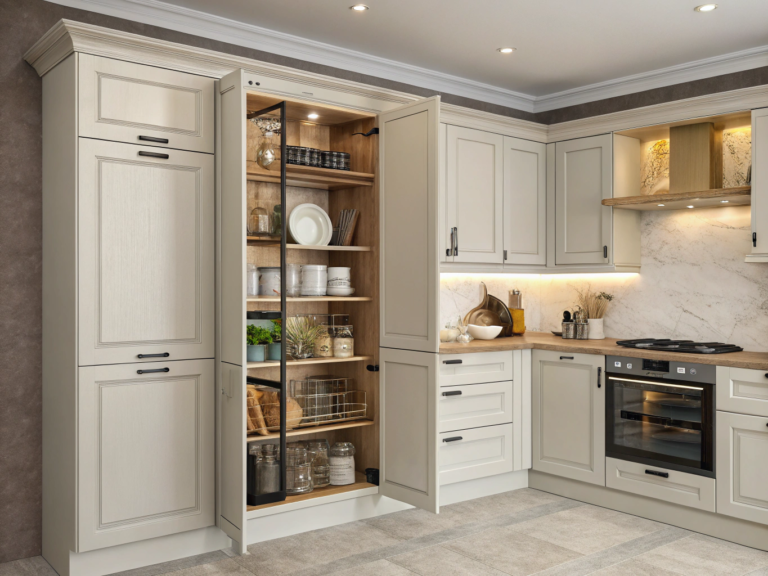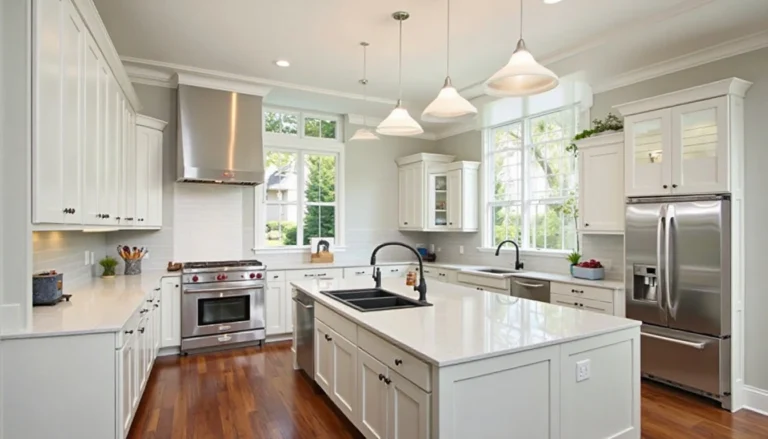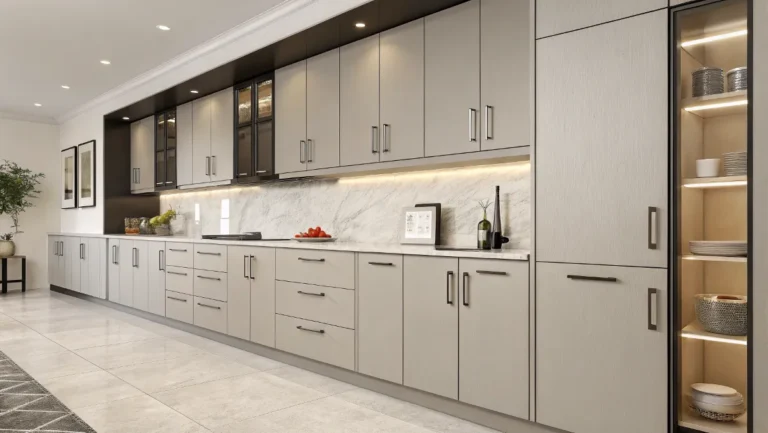How to Choose the Right Base Kitchen Cabinets
I remember the exact moment I realized I had no idea what I was doing. I was crouched on the kitchen floor, measuring what I thought was a “standard” base cabinet, while my toddler was sticking a banana peel in the drawer I’d just cleaned out. (This was after my third trip to Home Depot that week, you’d think I’d have figured it out by then.)
Here’s the thing: base kitchen cabinets aren’t just boxes under your countertops. They’re the workhorses of your kitchen, holding up your morning coffee routine, your late-night snack shame, your kid’s science project supplies (just me?). I used to think they were all the same. Spoiler: they’re not. There are drawer bases, sink bases, corner units, pull-outs, deep pots-and-pans drawers, and figuring out which ones to use (and where) felt like picking toppings at one of those frozen yogurt bars. Overwhelming, kind of fun, and very easy to mess up.
So if you’re standing in your kitchen right now wondering whether your cabinets are too shallow or why that drawer never quite slides right, this guide is for you. I’ll walk you through the real deal on base kitchen cabinets: what they are, what your options are, how to avoid my classic rookie mistakes, and (most importantly) how to make choices that actually fit your space and your life.
Because let’s be honest, you deserve a kitchen that works as hard as you do.
What Are Base Kitchen Cabinets?

Okay, confession time: when I first heard the phrase “base cabinets,” I pictured something super boring — like those nondescript boxes in an office break room. Turns out, base kitchen cabinets are everything in a kitchen. And I do mean everything.
They’re the cabinets that sit directly on your kitchen floor and hold up your counters (and your sanity). They’re where the pots live, the trash hides, and the kids’ cereal stash mysteriously disappears. You brush past them ten times a day without thinking, but when they’re wrong, like when that drawer sticks again or your sink base smells vaguely like mildew, you feel it.
Most base kitchen cabinets are about 34.5 inches high (before countertops), around 24 inches deep, and anywhere from 9 to 48 inches wide, depending on their function. But here’s the part no one told me: those numbers don’t tell you squat about how you’ll use them. A 36″ cabinet could be a double-door mess or a neat stack of drawers. And drawer stacks? Oh, don’t get me started, they’re either a dream or a regret, depending on what you need them to hold.
What makes base cabinets different from wall or tall ones? Think of it this way:
-
Wall cabinets float up top and mostly store pretty things or light stuff (or, in my case, tea I never drink).
-
Tall cabinets are for your pantry or broom closet situations, floor to ceiling, dramatic, great if you don’t mind the price tag.
-
Base cabinets are the daily grinders. The ones you open with your foot when your hands are full of taco ingredients. The ones that creak slightly when your dog nudges them, looking for crumbs.
These lower cabinets aren’t one-size-fits-all, either. There are sink bases (open backs for plumbing), drawer bases (love/hate), blind corners (ugh), pull-out spice racks, and even cabinet bases made for appliances like dishwashers and microwaves. You can customize them like puzzle pieces — but here’s the trick: the puzzle should fit your life, not just look good in a showroom.
What’s the real job of a base kitchen cabinet?
It’s not just about storage, it’s about flow. A good base cabinet setup makes prep, cooking, and cleanup feel like a dance. A bad one? Like tripping over your own feet while holding a hot casserole dish.
Standard Dimensions and Configurations
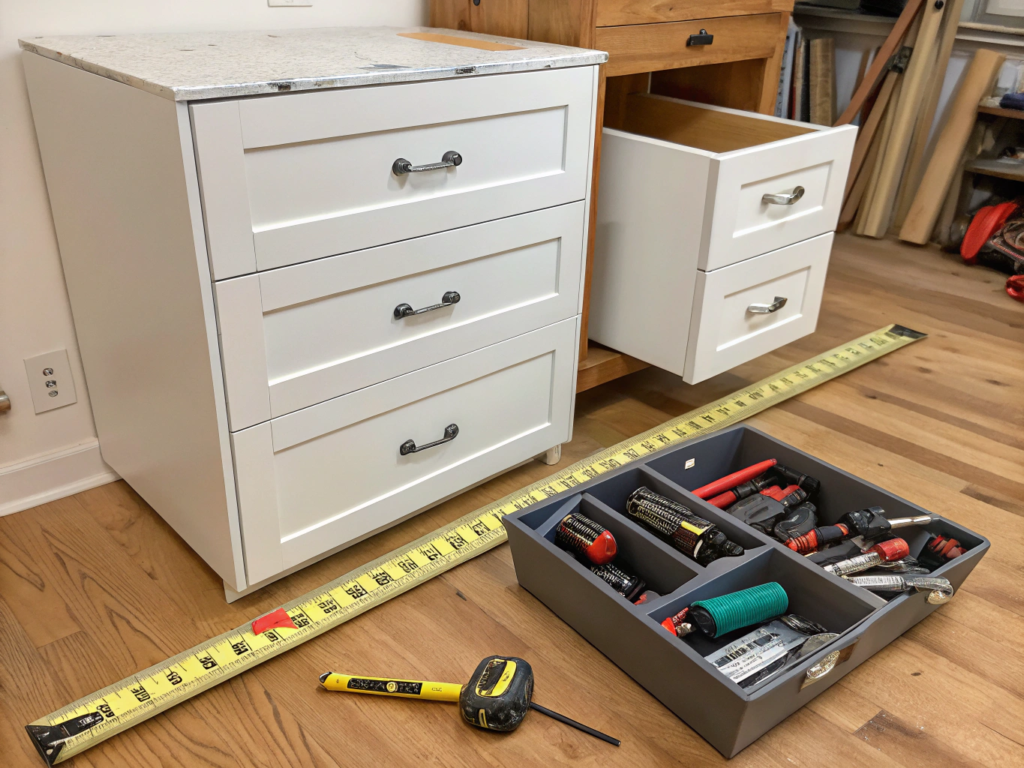
The first time I tried to “measure” my old cabinets, I used a fabric tape from my sewing kit. (Yes, really.) I was on the floor, squinting, the tape kept curling, and my toddler thought it was a snake. Needless to say, my numbers were… wildly off. So if you’re standing there holding a ruler from your junk drawer, I see you, and I’ve been you.
Let’s simplify this. Standard base kitchen cabinets have pretty reliable measurements, at least until you start customizing. Here’s the general breakdown:
-
Height: 34.5 inches without a countertop. Add a typical countertop, and you’re at around 36 inches, which is basically the sweet spot for most adults. (Unless you’re super tall or love to bake and want a lower surface for kneading dough. Been there, covered in flour.)
-
Depth: 24 inches from the front of the cabinet to the wall. Add another 1–1.5 inches for the countertop overhang. But be careful here, I once ordered a pull-out drawer that hit the oven handle every time I opened it. Rookie spacing mistake.
-
Width: Base cabinets come in widths ranging from 9 to 48 inches, usually in 3-inch increments. Narrow ones are perfect for spice pull-outs or sneaky vertical tray slots. Wider ones? Great for those deep drawers where you can finally fit your clunky stockpot.
These are what I call the “factory specs.” They work with most prefab or semi-custom setups, think IKEA, Lowe’s, or that budget line you found online at 2 a.m. But here’s the thing: measurements alone don’t mean much without context. A 36-inch-wide cabinet sounds roomy until you realize you can’t open it fully because your dishwasher’s in the way.
Are custom dimensions worth it?
Sometimes, yes, especially in quirky kitchens or small spaces. I had to shave 2 inches off a corner base once because my 1970s kitchen walls weren’t even close to straight. (Let’s just say there was caulk. Lots of caulk.) If your space is tight or weirdly shaped, a semi-custom or custom fit might be worth the extra bucks and hassle.
Types of Base Cabinets and Their Functions
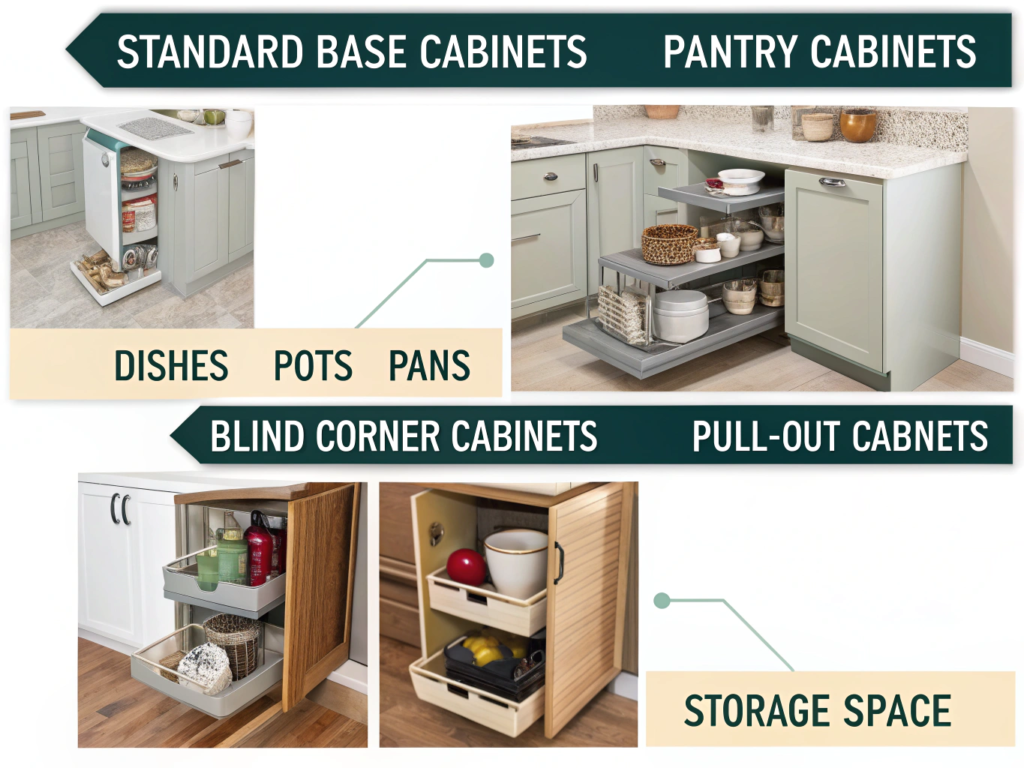
There was a moment, somewhere between trying to store a colander in a half-shelf sink base and losing a can of chickpeas to the blind corner, that I realized not all base cabinets are created equal. I used to think, “Cabinet’s a cabinet, right?” Oh, sweet summer Maya. Let’s break down the ones that actually make a difference.
1. Sink Base Cabinets
These are the open-back MVPs made to fit plumbing. No drawers, often no shelf, just space for pipes and (if you’re like me) an overflowing basket of cleaning sprays. I installed one once without realizing my sink’s drain was slightly off-center. Cue the hacksaw and a lot of swearing. Tip? Always double-check your plumbing layout before buying.
2. Drawer Base Cabinets
If you cook a lot (or just hate squatting to find lids), drawers are your best friend. These come in 3-drawer stacks or 2-drawer combos, and they slide out so you can actually see your stuff. I have one for utensils, one for snacks, and one that’s… mostly ziplock bags and chaos. Worth every penny.
3. Corner Base Cabinets
A.K.A. the Bermuda Triangle of kitchens. If you’ve ever lost a blender back there, you get it. Options include:
-
Blind Corner Units (awkward reach-ins, not my fave)
-
Lazy Susans (classic but clunky)
-
Pull-out Swings (fancy and space-saving if you’ve got the budget)
Honestly? I wish I’d splurged on a corner pull-out instead of the cheap spinner. Nothing like watching your pan lids launch themselves into oblivion every time you turn them.
4. Pull-Out Base Cabinets
Skinny but mighty. These are the vertical sliding cabinets, usually 6 to 12 inches wide, that store spices, oils, cutting boards, or cleaning supplies. I installed one next to my stove, and it changed my life. No more digging in dark corners for paprika.
5. Open Shelf or Display Base Units
Rare, but great for baskets, cookbooks, or if you want that “Pinterest kitchen” look. Warning: You’ll have to dust. I had one once. It became a clutter magnet in two weeks flat.
Which base cabinet should you never skip?
A drawer base. Seriously. Even just one. It makes everything feel more accessible, especially for stuff you use every day, like measuring cups, snacks, or whatever’s always mysteriously missing
Design Considerations: Style Meets Function
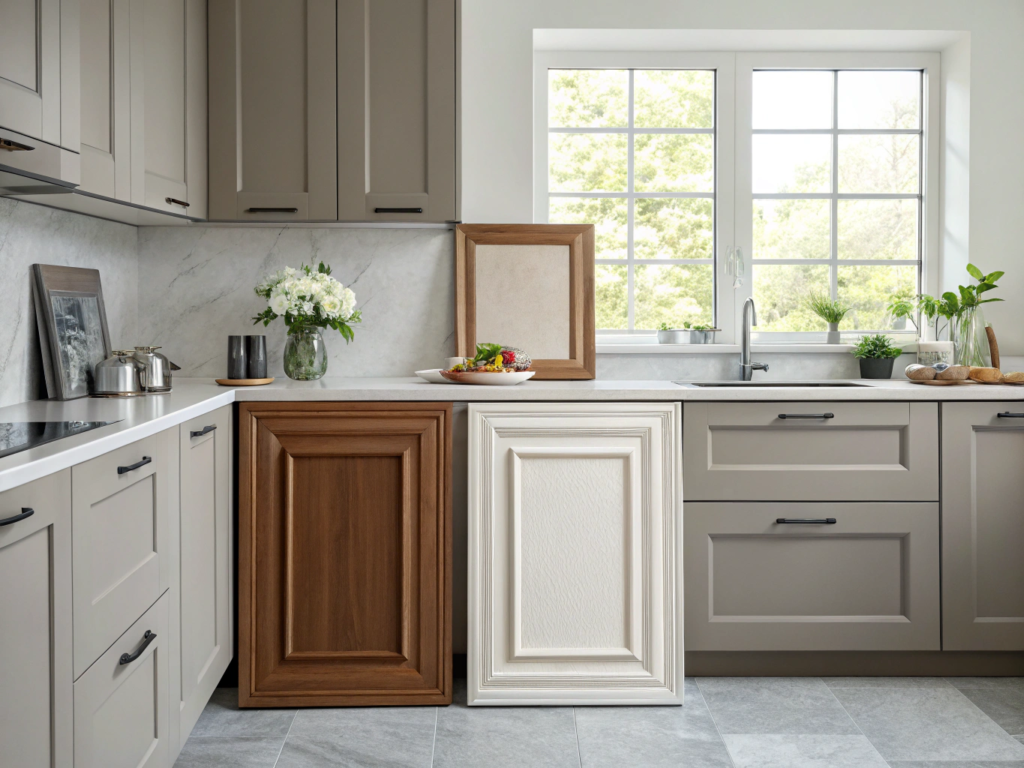
I still remember the afternoon I stood in my kitchen holding two cabinet samples, one with a frame, one without, and thinking, Why do these even exist? Aren’t all cabinets basically the same? (Spoiler: they are not. And yes, I picked the wrong one the first time.)
Turns out, the way your base cabinets are built plays a huge role in how they feel, and how they hold up to sticky fingers, muddy shoes, and that rogue toy car that keeps ending up under my sink.
Framed vs. Frameless: The Personality Test for Cabinets
Let’s break it down real-talk style:
-
Framed cabinets have a border around the front. Think of it like a picture frame, classic, a little more forgiving if your walls are older than your mortgage, and great if you want that “warm, cozy kitchen” feel. I used these in my first reno and loved the charm… until I realized I kept bumping pans against that center stile.
-
Frameless cabinets skip the frame and give you full access. They’re like open-concept layouts for your drawers. Sleek, modern, and surprisingly roomy, but they do not hide flaws well. I installed a set in our last place and had to shim like my life depended on it because the floor sloped like a ski hill.
Honestly, it comes down to vibe and patience. If you want something classic and low-stress during installation? Framed. If you love that clean European style and don’t mind leveling every inch? Frameless.
Toe Kicks vs. Fancy Legs: The Underestimated Decision
Ah, the toe kick. I didn’t even know what it was until I tried to sweep under our first furniture-style base and accidentally smacked my shin. Twice.
-
Toe kicks are that recessed spot at the bottom of your cabinets where your feet naturally tuck in. You don’t notice them… until they’re gone. Suddenly, cooking feels like leaning over a fence. They’re also magic for hiding cords, outlets, or that one sock your kid swears isn’t his.
-
Furniture-style legs look adorable. I get the appeal. But unless you’re planning to vacuum daily or live without pets (or dust), they’re more effort than they’re worth. I tried them once under a prep area and immediately regretted it when I dropped a blueberry and had to crawl under to retrieve it. Not elegant.
What’s my go-to combo?
Frameless drawers with a clean toe kick, plus one framed cabinet for charm. It gives you the sleek function where you need it and the “lived-in” look where it counts, like a comfy kitchen sweater with one fancy button.
Material and Build Quality: What to Watch For
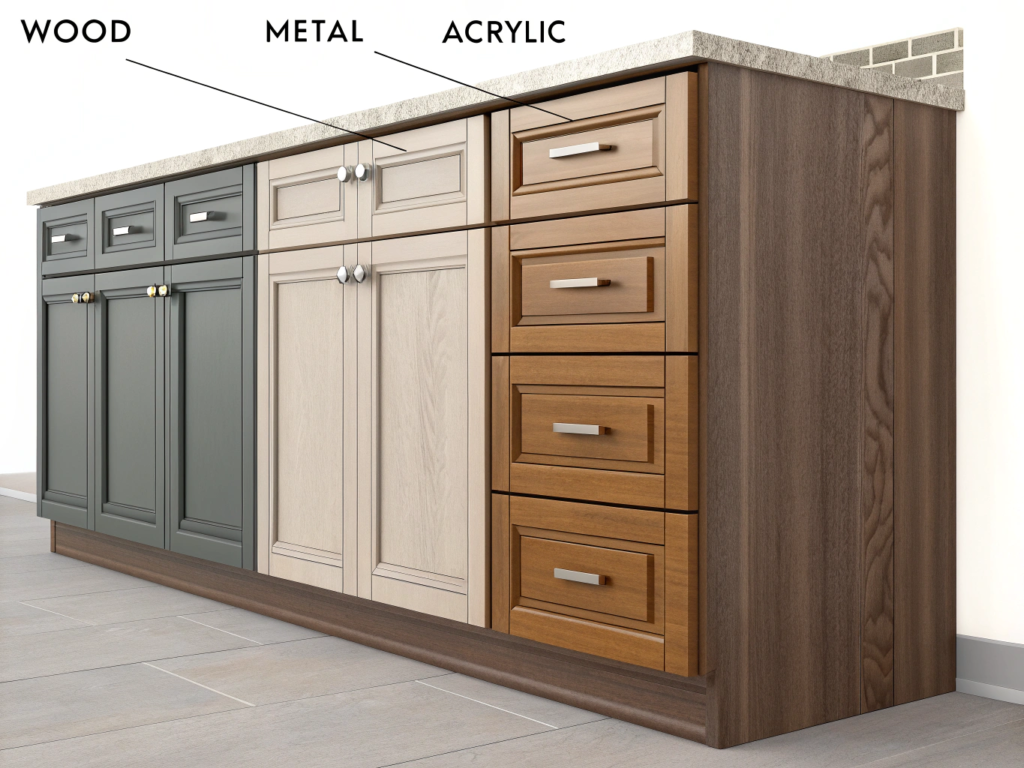
I once bought a clearance base cabinet online because it looked “just like the expensive ones.” (Famous last words, right?) It arrived three weeks later, dented, wobbly, and smelling faintly like glue. I tried to install it anyway. The bottom literally buckled the first time I loaded in my cast iron pan. Lesson learned: not all cabinets are created equal.
If you’re knee-deep in the kitchen remodel spiral and wondering whether materials matter, here’s the short answer: absolutely. Especially for base kitchen cabinets, which take all the abuse, dropped pots, splashed spaghetti sauce, curious toddlers, and let’s not forget… gravity.
Material Basics: What’s Inside Counts
Let’s decode the main options:
-
Plywood: The solid, stable champ. It’s layers of wood veneer glued together in alternating directions, which makes it strong and fairly water-resistant. Most high-end or semi-custom cabinets use it. I splurged on plywood for my sink base the second time around, and zero regrets, it held up beautifully even after a mild under-sink leak.
-
Particleboard: Cheaper, flimsier, and what most budget cabinets are made of. It’s basically sawdust and glue, think IKEA’s lighter lines. Works fine for light use, but moisture is its mortal enemy. My old drawer base? Swelled up after a mop mishap and never recovered.
-
MDF (Medium-Density Fiberboard): Smoother than particleboard and great for painted finishes, but still not as tough as plywood. It’s heavy and can chip easily if you’re rough on your drawers (guilty).
-
Solid Wood: Sounds fancy, but honestly? Not always better. Wood expands and contracts with humidity, so it’s not the top choice for structural parts like cabinet boxes. Better used for doors and drawer fronts if you want that natural grain look.
Hardware & Construction: The Small Stuff That Matters
Beyond the big materials, watch for:
-
Drawer glides: Soft-close? Yes, please. Side-mounts are okay, but under-mounts give that “fancy cabinet” feel.
-
Hinges: Cheap ones loosen quickly. Look for adjustable, soft-close options with a solid feel.
-
Finish quality: Painted cabinets should feel smooth, not plasticky or sticky. Stains should show wood grain (unless it’s MDF, then it’s all smoke and mirrors).
Is it worth paying more for plywood?
If it’s for a high-traffic cabinet, absolutely. Especially under the sink or near your stove. I tried saving $40 by going with particleboard once. It bowed. I cried. End of story.
Installation Tips and Layout Pitfalls

If you’ve ever balanced a 36-inch cabinet on a stack of paint cans because your floor isn’t level and your husband’s “holding it steady” with one hand while sipping coffee — welcome to DIY base cabinet installation. (Yes, this happened. Yes, it fell. Yes, the dent is still there.)
Installing base kitchen cabinets sounds simple on paper: level, screw into studs, repeat. But once you throw in uneven walls, surprise pipes, and “where did I put the stud finder?” chaos, things get real, fast.
Layout Tips from Someone Who Learned the Hard Way
1. Start from the highest point on the floor.
I didn’t. I started in the corner that looked flat. By the third cabinet, I had a slanted countertop and a weird gap near the stove that collected crumbs for months. Use a long level, find the highest point, and shim everything else to match.
2. Plan your workflow zones.
Think in stations: prep, cook, clean. I once placed my trash pull-out across the kitchen from my sink. Ever try carrying a dripping bag of scraps across tile while your dog chases you? Don’t. Keep your trash, sink, and prep space in a triangle if you can.
3. Leave breathing room.
Cabinets expand a tiny bit with humidity, plus, walls are rarely perfectly square. I once jammed a 36″ cabinet into a 36″ opening. Spoiler: it didn’t fit. Leave a smidge of wiggle room and use fillers if needed. You’ll thank yourself later.
4. Label everything.
When you’re working with flat-pack cabinets or swapping multiple units, label the backs with painter’s tape. My neighbor Linda watched me install two drawers upside down before gently suggesting I might need a break. She was right.
Can I really install base cabinets by myself?
Yes, if you have patience, a level, and a second set of hands.
I’ve done it with a tired drill, a box of shims, and the moral support of my cat. It’s doable. But if you’re tackling more than one or two, or if plumbing and electrical are involved, consider calling in a pro. (Your back will thank you.)
Frequently Asked Questions About Base Kitchen Cabinets
You know that moment when you’re four YouTube videos deep and still don’t know if you can stack two base cabinets? Yeah. I’ve been there too. Here are some of the questions I either Googled myself or wish someone had answered before I started.
Can I stack two base cabinets on top of each other?
Technically, yes. But should you? Probably not, at least not without some serious planning. Base cabinets aren’t built to support that kind of vertical load long-term. Plus, it’s going to look bulky unless you trim it out like a tall pantry. If you’re trying to get extra height, consider wall cabinets mounted lower or custom solutions instead. I once tried to “stack” with scrap wood just to hold extra baking pans — it lasted about two weeks before wobbling like a bad Jenga tower.
How deep should base cabinets be?
Standard depth is 24 inches. That gives you enough room for a countertop overhang and still lets drawers open fully. You can go deeper (up to 30″) if you’ve got a big kitchen, but be careful, you’ll lose walking space. I once installed deeper cabinets on an island and nearly backed into them every time I opened the fridge. Live and learn.
What’s the best base cabinet layout for a small kitchen?
Drawers, drawers, drawers. Especially wide ones with full-extension slides. They give you better access without making you crouch like a cave explorer. Skip lazy Susans if you can, they eat up corner space and rarely fit big pans. I swapped mine for deep corner drawers, and hallelujah, no more Tupperware avalanche.
Do I need cabinet fillers?
Yes, and don’t wait until the end to think about them. Fillers (those skinny little panels between cabinets or walls) save your drawers from slamming into door frames. I didn’t account for one between my cabinet and stove, and now there’s a permanent dent where the handle used to hit. It’s a tiny piece that makes a huge difference.
Conclusion: Designing a Kitchen You’ll Love Using
If you’d told me a few years ago that I’d have strong opinions about toe kicks and drawer glides, I would’ve laughed, probably while standing next to my wobbly particleboard cabinet with the peeling laminate. But here we are.
Base kitchen cabinets aren’t just storage. They’re the pieces that shape how you move, cook, clean, and live in your kitchen every single day. They hold your messes, your meal prep, your kid’s crayon collection (ask me how I know), and all those tiny moments that somehow turn into memories.
So whether you’re installing them solo with a half-charged drill or picking them out with a contractor who speaks in inches and angles, take your time. Think about how you use your space, what makes you smile when you walk into the room, and where that sneaky cutting board will fit.
You don’t need fancy or flawless. You just need cabinets that work for you. That’s the kind of kitchen you’ll want to cook in, and trust me, that matters more than getting the trendiest finish.
Hope this helps! (And saves you from a few of my mistakes.) Let me know if you try any of these tips. I’d love to hear how it goes for you.


